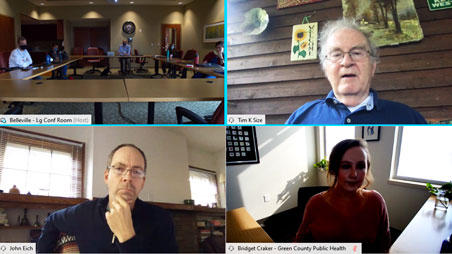
Public Health Educator Bridget Craker (bottom right) shared a perspective from the Green County Health Department at the virtual RHET Advisory Board meeting.
The Rural Health Equity Track (RHET) Advisory Board met virtually in September to discuss COVID-19 and the rural lessons learned. The board, established in 2017, is comprised of community members from the Rural Wisconsin Health Cooperative; the Wisconsin Collaborative for Rural Graduate Medical Education as well as rural physician leaders; staff from the UW Health Belleville Clinic; and RHET and rural pathway residents, alumni, faculty and staff. Its purpose is to provide progressive and experienced foresight and leadership to the training of family medicine resident physicians who will become exceptional doctors in rural, underserved Wisconsin communities.
COVID-19 in Our Rural Communities
Neal Smith, MD, a RHET resident at the Belleville Clinic, opened the meeting with some sobering statistics. Green County, located just south of Dane County, has a seen a steady increase in COVID-19 cases and hospitalizations since August. The mostly rural county of almost 37,000 had 428 confirmed cases on September 18. That number grew to 1,063 cases as of November 1. The trend is concerning for communities already facing greater health disparities. “Fifteen percent of our rural population has a disability and one in five people living in rural settings are over the age of 65,” said Smith. “These are added risk factors for developing severe complications from COVID-19.” Lack of community testing locations and a continued trend of fewer rural hospitals and family medicine physicians makes fighting the pandemic particularly challenging.
Planning and Preparing
At Upland Hills Hospital in Dodgeville, WI, Chief Medical Officer and Vice President of Medical Affairs Charles Pearce, MD, formed a team after the first COVID-19 case was reported in Wisconsin on February 5. Infection control and medical staff leadership met weekly to establish a line of communication with inpatient/outpatient directors, respiratory therapists and hospitalists and started reviewing available personal protective equipment (PPE). By March, incident command was initiated, they locked down their Nursing Rehabilitation Center, paused elective surgeries and non-emergency services, designated sick/well clinics, and initiated a plan for virtual patient visits. A drive-thru COVID-19 testing process was created and launched within two days. “In early May, we were able to restart surgical, radiographic and therapy services thanks to the availability of universal hospital admission testing and scaling up N95 mask conservation strategies,” said Pearce. “By June our Incident Command Center was paused as cases dropped and a Recovery Committee was created to focus on recovery of services.” Between March and July, clinic and ER volumes at Upland Hills dropped by 25%; surgical services dropped by 75% but have rebounded to near normal levels. As of September 22, Upland Hills had only a total of six COVID-19 admissions throughout the entire pandemic—significant for a facility of approximately 20 beds with only three being ICU beds. As cases now surge in Wisconsin, Upland Hills recently had 9 COVID-19 patients admitted at one time. “We learned a lot in the early stages of this pandemic,” said Pearce, “but having access to enough testing and proper PPE continues to be an ongoing focus. We are also concerned with the mental health and vulnerability of our staff due to illness, exposures and family obligations such as virtual schooling for children.”
Access to Resources
Public Health Educator Bridget Craker joined the conversation to share a perspective from the Green County Public Health Department. Until recently, very little testing for COVID-19 was available and people needed to travel to Dane County or Illinois to receive a test—but that isn’t the only obstacle faced by people living in rural communities. Access to vital information, childcare, masks and even food have caused concern. “Without reliable internet, working from home and virtual school is not possible for many people,” said Craker. This also led to problems with disseminating information. Initial communications about the virus, safety protocols, and testing were posted on the Green County Public Health Facebook page and website.
“We’ve worked to address some of these gaps by diversifying communication methods to include newspapers and radio, offering free masks, and by expanding access to free testing by opening additional sites,” added Craker. “We also appreciate the work of the United Way and other organizations offering childcare and support for food pantries.” Direction from the Centers for Disease Control and Prevention and Wisconsin Department of Health Services has helped guide the implementation of programs like Mask up Green County—an effort designed to educate, promote mask wearing and make masks accessible to all. Craker also believes gaining the public’s trust at a time when the pandemic response has become politicized is vital. “We continue to use positive messages to emphasize the importance of community members doing their part to help each other,” she said.
The Next Phase
As the board meeting ended, it was apparent that the successes and lessons learned are crucial to future decisions as we enter the 8th month of the COVID-19 pandemic. Craker believes their efforts have made the public much more aware of public health and infection control measures like hand washing and staying home when sick. “We are working to break the stigma some feel when they have a positive test,” shared Craker. “Gaining and maintaining trust is important for contact tracing and for the overall health of our communities.”
Published: November 2020
